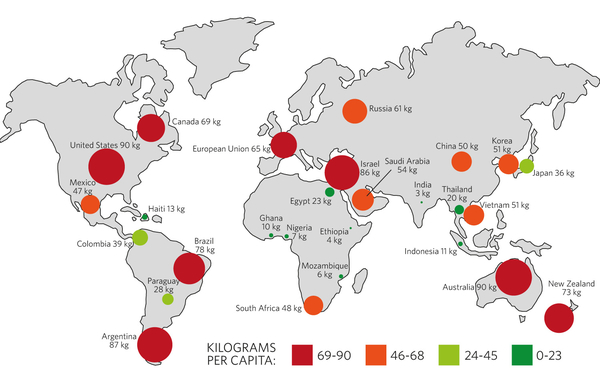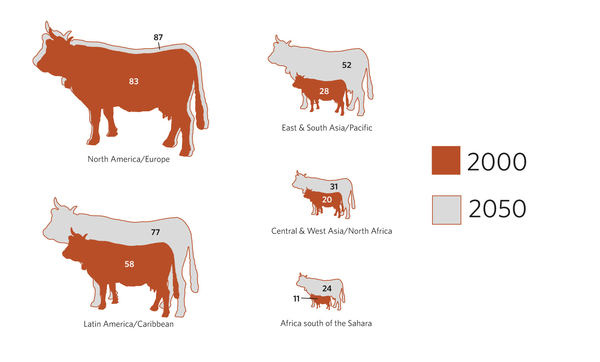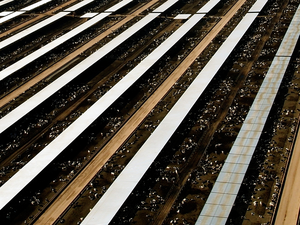
When we think of the big drivers of climate change, cars and air travel often come to mind. But transformations over the past century in the way food is produced and consumed have resulted in more greenhouse gas emissions than those from transportation. The biggest culprits? Industrial meat and dairy.
The most widely cited official estimate holds that the food system is responsible for up to 30 per cent of all greenhouse gas (GHG) emissions.[1] Some of these emissions are due to the growth of packaged and frozen foods, the increased distance foods are shipped and the rise in food waste. But the most important source of food system-related GHG emissions is the escalation of meat and dairy consumption—made possible by the expansion of industrial livestock and chemical-intensive feed crops. The UN Food and Agriculture Organisation (FAO) says meat production alone now generates more GHG emissions than all the world’s transport combined.[2]
There is no way the world can continue down this path without wildly overshooting the target, set by governments in Paris last year, of two degrees Celsius by 2050.[3] Cutting meat and dairy consumption is imperative, especially in the US, Europe and other wealthy countries that have subsidised industrial meat and dairy production for decades. These countries’ policies have generated astronomical profits for corporations and eroded the health of their citizens while worsening the climate.
Cutting consumption first requires understanding which meat and dairy production systems are most at fault, and the mechanisms and policies that prop them up. Herders in poor countries and small farmers practising diversified crop and animal production are not the problem. Factory farming—promoted by the industrial meat lobby, corporate subsidies and free trade agreements—is the real climate culprit.
Box 1. Added benefits of reducing meat and dairy consumption
In addition to reducing global greenhouse gas emissions, reducing consumption in the countries that currently eat too much meat and dairy could have significant health and social welfare benefits. One study shows that reducing meat consumption as a means of fighting climate change would also cut the risk of colon cancer, heart disease and lung disease worldwide by 34 per cent.[31] Another says it would reduce global mortality by 6 to 10 per cent by 2050, translating into a healthcare cost savings of US$735 billion per year.[32]
Other scientists point out that cutting meat and dairy consumption would cut infectious disease and reduce the emergence of antibiotic resistance, and have secondary effects as well.[33] One model shows that the worldwide adoption of a healthy diet could reduce mitigation costs for the energy sector by more than 50 per cent by 2050.[34] It would also free up land now used for animal feed production and, if combined with other policy measures, could help small farmers access much needed land.
The answer, quite simply, is yes. Decreasing meat and dairy consumption, especially in North America and Europe, would make a significant impact.
Like fossil fuel consumption, unsustainable meat consumption is driven primarily by rich countries. Countries like the US and Australia are the biggest consumers of meat worldwide with some 90 kg per person per year, followed closely by some countries in Latin America and the EU, Canada and Russia. In India it’s a mere 3 kg (see figure 1).[4] Compounding the disparity is the fact that a large share of US and European meat consumption is composed of beef, which emits far more GHG than pork or chicken. North America, the EU and Brazil together account for half of all beef consumed worldwide.[5]
Figure 1. How much meat do people eat around the world?
Emissions from meat are on the rise in China too (already at 58.2 kg per person per year), Vietnam and other countries where fast food restaurants, meat imports and factory farming are rapidly expanding. If these trends continue, world meat consumption will grow by a whopping 76 per cent by 2050, while emissions from dairy, another major source of food sector emissions, will increase by 65 per cent.[6]
As one recent study found, if people simply kept their meat consumption to the World Health Organisation’s recommended guidelines, the world could reduce some 40 per cent of all current greenhouse gas emissions![7]
The benefits of such a shift would be felt rather quickly. Methane, the major greenhouse gas from livestock, remains in the atmosphere for only ten years, compared to carbon dioxide, which lasts up to 200 years. Methane also traps 28 times more heat than CO2. Consequently, lowering the production of methane can have a relatively quick payoff. In addition, reducing food waste—especially meat—can have an important impact. One third of the food we produce is wasted, generating about 4.4 gigatonnes of GHG emissions each year. Although meat accounts for less than 4 per cent of food waste by weight, it accounts for an astonishing one fifth of the global carbon footprint of food waste.[8]
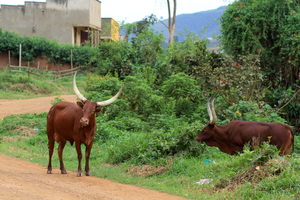
Factory farms are the problem, not small farmers and herders
Small farmers and pastoralists do not have to lose from a decrease in global meat and dairy consumption. In most of the Global South—where meat and dairy consumption is at sustainable levels—livestock is raised mainly by 630 million small farmers practising low-emissions, mixed farming, plus 200 million herders who often graze their animals in areas where crops cannot be grown.[9] Not only do these production and consumption systems contribute little to climate change, the diversity of their systems creates positive synergies between crops and livestock (such as recycling animal waste and crop residues) and a “multifunctional” use of livestock (for traction, energy, labour, hide and cash). Small-scale livestock production also enhances family nutrition, giving people access to both animal and plant based foods. In these systems, livestock is an essential part of people’s livelihoods, food security and health, as well as an integral part of cultural and religious traditions.
Industrial meat and dairy production, however, sits at the other end of the spectrum. It is based on the highly concentrated production of cheap meat and powdered milk surpluses, which are traded as global commodities. This surplus production is what underpins the unsustainable growth of global consumption—and the spectacular rise of GHG emissions.
Factory farms are the most rapidly growing segment of meat and dairy production. They account for 80 per cent of the growth of global meat and dairy in recent years.[10] Industrial livestock production has grown at twice the annual rate of traditional, mixed farming systems, and at more than six times the annual growth rate of production based on grazing. This is especially the case for pigs and poultry, as factory farms now account for 74 per cent of the world’s total poultry production, 40 per cent of pig meat and 68 per cent of eggs.[11]
Figure 2. Projected increase in meat consumption by region* (kilograms per person)
A lot of the GHG emissions generated by industrial livestock occur indirectly, through the production of feed. In 2010, about one third of all cereals produced went to feed, and the FAO predicts this figure will reach 50 per cent by 2050.[12] More feed means more land under cultivation. An additional 56 million hectares of land were cultivated with soybeans and maize for animal feed in the first decade of the twenty-first century, resulting in the release of copious amounts of carbon dioxide through land use changes and deforestation.[13] In addition, feed crops are usually grown with chemical fertilisers, another powerful source of greenhouse gas emissions. Because of the expansion of factory farms, the production and processing of feed for animals now account for almost half of livestock’s greenhouse gas emissions—and this is expected to grow.[14]
Another major source of GHG emissions from factory farms is manure. The industrialisation of livestock means concentration, i.e. fewer farmers and more animals per farm. The sheer scale of the operations turns manure from a valuable natural fertiliser into a toxic problem. In the US, where this process is very advanced, in the early 1990s less than one tenth of dairy cows were kept in herds of more than 1,000 cows. By 2007, this figure had risen to one third. The same year, feedlots with a capacity of over 16,000 animals raised for beef were handling 60 per cent of US-fed cattle marketing.[15] The same, or worse, is happening in the pig and poultry sectors.
According to the FAO, manure storing and processing are responsible for 10 per cent of all greenhouse gas emissions related to livestock worldwide.[16] A lot of that comes from concentrated animal feeding operations or “CAFOs”. The manure deposited by animals onto pasture produces about six to nine times less volatilised ammonia than surface-applied manure from CAFOs.[17] Alex Turner, a researcher at Harvard University studying manure waste lagoons, found they emit about 35 times more methane than manure that is left in the field.[18] Due to the tremendous growth in factory farming and waste lagoons in the US, overall methane emissions from manure grew by more than two thirds between 1990 and 2012.[19]
Finally, a central but often overlooked climate factor is livestock’s reliance on fossil fuels. According to the FAO, 20 per cent of the emissions generated to produce meat and dairy come from the use of fossil fuels[20]. Most of this comes from factory farming, with its need for animal feed and the fertilisers used to grow it. It also comes from the distribution and retail systems that industrial farming relies on, which demands electricity, heating, transport and refrigeration.
Meat lobby undermines climate action
Factory farming—and our appetite for meat and dairy—are not only deadly for the earth’s climate, they create a wide range of other environmental and social ills. Scientists have been warning of this problem for at least a decade now. But efforts to tackle the issue invariably bump up against aggressive resistance from meat and dairy companies, who have the most to lose from actions that reduce consumption and curb factory farming.
“I have been hit on the head several times for suggesting that people should eat less meat", says Rajendra Pachauri, the chairman of the Intergovernmental Panel on Climate Change from 2002 to 2015. “I was the target of several efforts to discredit me”.[21]
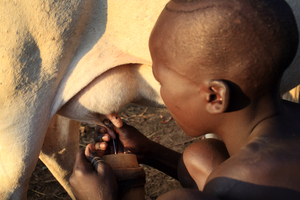
The FAO was blasted by the meat industry after it released a report in 2006 putting livestock's share of global GHG emissions at 18 per cent. "You wouldn't believe how much we were attacked", said Samuel Jutzi, director of the animal production and health division of the FAO.[22] The FAO soon buckled under the pressure and agreed to establish a partnership with the meat industry's main lobby groups to jointly reassess emissions from livestock.[23] Both the partnership's Steering Committee and its Technical Advisory Groups are dominated by representatives of meat companies, their lobby groups and scientists funded by meat and dairy companies.
As a result of the FAO's partnership with industry, it has shifted its focus towards a narrow assessment of “emissions intensity”, in which GHG emissions are examined per unit of output (per kg of meat, litre of milk or unit of protein). Measured this way, animals that are intensively raised for maximum output of meat and milk—by a few million farmers mostly in the US, Europe, Brazil, New Zealand and a few other rich countries—have a lower “emissions intensity” than the animals of poor farmers, which are raised for many more uses and without access to the high protein feed, antibiotics, growth promoters and hormones used by intensive livestock industries. Poor farmers are thus said to suffer from an “emissions intensity gap” and should be pushed into what is termed “sustainable intensification” or, more broadly, “climate smart agriculture”.[24]
Box 2. Top ten beef, dairy, pig and poultry companies
When it comes to cattle, the bias towards industrialisation is made worse by the fact that scientists and policymakers often do not take into account the carbon storing capacity of natural grasslands in their calculations. For example, in its 2013 report on livestock and climate, the FAO admits that it cannot estimate changes in soil carbon stocks under permanent grasslands “because of the lack of global databases and models”.[25] Yet it underscores the fact that the capacity of well-managed grasslands to absorb carbon from the atmosphere can be significant, especially in the tropics where permanent pastures are common and carbon sequestration is high.
Grasslands currently cover a quarter of the earth’s surface and account for two thirds of our agricultural land, so the implications are enormous. Especially if one considers the ecological and climate consequences of ploughing them under to grow feed crops for industrial livestock. Between 2009 and 2015, 21 million hectares of grassland in the US alone were converted to crop production—much of which to feed industrial livestock—releasing enough carbon into the atmosphere to put 670 million extra cars on the road![26]
The larger issue is that the "emissions intensity" model of calculations, which is now being pushed by meat and dairy companies as the basis for national policies, completely sidesteps the connection between systems of production and levels of consumption, as well as the numerous environmental, social, health and animal welfare benefits of small-scale mixed farming and pastoralism (see Figure 4. Good cow, bad cow). It favours technical tweaks to the status quo rather than the major shift away from industrial meat and dairy that is urgently needed. Finally, it unfairly places the burden of emissions reduction on small-scale livestock holders in poor countries who bear no responsibility for the climate crisis.
Box 3. What governments are already doing
Thumbs up
▪ Denmark: In May 2016, the Danish Ethics Council called for a national tax on red meat.[35]
▪ Sweden: In 2013, the Swedish Board of Agriculture proposed a differentiated tax on meat (meat that generates the most GHG emissions to be taxed more than meats producing less) to be set up at the EU level.[36]
▪ China: In June 2016, Beijing announced a bold new policy that aims to cut people's current meat consumption by 50 per cent (to 40g daily) through new national dietary guidelines.
▪ California: In August 2016, the state of California, which produces 20 per cent of the US milk supply, enacted a law saying that dairy farms must cut GHG emissions by 40 per cent by 2030. While the objective is bold, the risk is that it leads to more concentration around a few big farms that can afford to install methane reactors.
▪ Ireland: In October 2016, Irish authorities released a first study on the carbon footprint of the average Irish person's diet.[37] Red meat accounts for 40 per cent of all food-related emissions. The government may now consider incorporating climate concerns into the nation's dietary guidelines.
▪ Netherlands: In 2016, the Netherlands Nutrition Centre recommended that Dutch citizens reduce their weekly meat consumption to less than 500g (half of what the USDA suggests), and limit red meat consumption to 300 g per week because of “the livestock industry’s massive environmental impact”.[38]
Could do better
▪ Nordic Council: In 2012, the Nordic Council issued dietary guidelines that call for limiting consumption of processed and red meats, and replacing high-fat meat with low-fat meat.
▪ Sweden: The National Food Agency recommends that people in Sweden eat less meat and choose plant based foods instead, in the interest of the environment.[39] It specifically suggests that people eat vegetarian once or twice a week.
▪ Finland: In 2014, Finland adopted dietary guidelines that recommend reducing red meat consumption to less than 500 g per week in the interest of “sustainable development”, not just health.
▪ EU: The EU's “roadmap to 2050” states that GHG emissions from agriculture will rise to one-third of the EU's total emissions by 2050. Actions proposed include: cutting emissions from fertilisers, manure and livestock; increasing storage of CO2 in soils and forests; and recommending that citizens consume locally produced, seasonal foods, eat more vegetables than meat and specifically reduce beef consumption.
Thumbs down
▪ Germany: In May 2016, Germany's draft plan to meet the Paris Agreement targets, drawn up by the Ministry of the Environment, was leaked. It proposed to: cut the country's meat consumption by 50 per cent by 2030, calling the reduction of livestock herds “crucial for climate protection”; cut GHG emissions from German agriculture from 72 million tonnes in 2014 to 55 – 60 million tonnes by 2030, preserving meadows and pastures in this process; and get 20 per cent of all land under environment-friendly farming. The final plan, released in November 2016, after much lobbying and debate, was gutted. It no longer calls on Germans to cut back on meat consumption and sets no targets for the reduction of GHG emissions in the agricultural sector.
▪ United States: The US revised its national dietary guidelines in 2015. Instead of calling on people to cut back on meat consumption, it recommends the consumption of lean meats. This outcome has been attributed to “very substantial" lobbying by the US livestock industry to prevent any linkage in the debate between livestock and climate, and any change in dietary patterns.[40]
▪ Brazil: In 2014, Brazil revised its national dietary guidelines. They do not discourage meat or dairy consumption, only that of highly processed animal-based foods.[41]
It’s time to take action!
If we wish to make a significant dent in climate change, we have to be clear that industrial meat and dairy are the real problem. While support for small-scale producers and pastoralists to move towards more sustainable methods where needed is important and welcome, the growth of industrial meat and dairy systems needs to be reversed first and foremost. The drive to cut meat and dairy consumption must be directed towards the big offenders: North America and Europe, plus a few countries in Latin America like Brazil. Some governments in these regions are starting to get on board and taking steps to get people to eat less meat, as is China, the country with the fastest growing meat consumption (See Box 3. What governments are already doing).
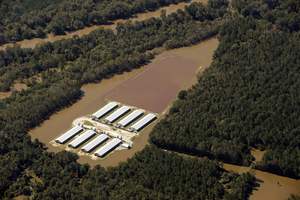
One common first step is to revise dietary guidelines to officially call for a reduction in meat consumption, at least red meat. Sometimes this step comes across road blocks from the industry. The US meat industry, for instance, recently spent $3 million lobbying to stop the US government from enacting dietary guidelines that recommended a reduction in meat consumption.[27] The implications of such guidelines would have been that schools, hospitals, prisons, public offices and other work places cut their purchases of red meat, especially as educational campaigns and labelling initiatives roll out to support implementation.
Other governments are looking at a range of fiscal measures they can deploy to raise the price of meat and dairy in a responsible way and deter consumption, as they are doing with sugar, fats, fizzy drinks and tobacco. One measure is to eliminate the reduced value-added tax that many countries apply to meat to keep it artificially cheap. Another is to impose a tax on meat, especially beef. This gets controversial, as some worry it could disproportionately affect lower income households. Another risk is that it could drive people to consume industrial pork and chicken instead of beef, which may lessen climate impacts but would lead to other environmental and health problems.
So people are looking at how to make a socially positive tax, e.g. a differentiated tax just on industrial meat or a tax that is coupled with subsidies or other income redistribution measures to make locally and sustainably produced meat and non-meat alternatives available and affordable, especially in low income communities. Difficult debates over carbon taxes show that these discussions need to be participatory in order to be equitable and effective.
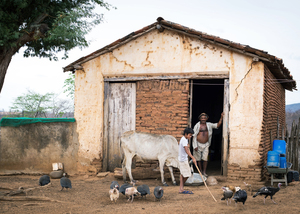
We also have to look at the deeper underlying causes of the overconsumption of cheap industrial meat and dairy. This means addressing the enormous subsidies behind this industry. In 2013, OECD countries dished out US$53 billion to livestock producers, with the EU paying US$731 million to its cattle industry alone.[28] The same year, the US Department of Agriculture paid more than US$500 million to just 62 producers (starting with Tyson Foods) in order to get meat and dairy on school meal trays, compared to just a fraction of that to fruit and vegetable suppliers.[29]
Indeed, almost two thirds of all US farm subsidies go to meat and dairy, much of it through animal feed.[30] Instead of propping up agribusiness, support must be given to farmers to scale back and convert to agroecological livestock production methods as part of a broader shift in public finance and food policy.
Finally, on the trade and marketing side, we urgently need to reverse the push for global meat and dairy “value chains” as enshrined in big trade agreements between major trading blocks (See Box 4. How trade deals drive the expansion of industrial meat and dairy). These accords artificially prop up production and consumption by promoting the dumping of cheap meat and dairy into poor countries’ economies. This is not only killing local livelihoods, it is also killing our climate. We need to recognise this and redirect both investment and policy support to local, national and regional markets for sustainably produced livestock.
Box 4. How trade deals drive the expansion of industrial meat and dairy
▪ By forcing tariffs to go down in the last “protected” markets. This is very much a threat in countries where tariffs are still in place to protect local farmers from foreign competitors, or where farmers benefit from subsidies and other price distorting mechanisms. This includes low income countries like India, which is now facing the Regional Comprehensive Economic Partnership (RCEP) trade deal. RCEP will have a big impact on India's meat and dairy sector, forcing it to open it up to imports from Australia and New Zealand. But tariffs are also an issue in the high income countries negotiating the Transatlantic Trade and Investment Partnership (TTIP) agreement, which aims to open the EU to more beef imports from the US, as well as those involved in Trans-Pacific Partnership (TPP), in which US corporate access to meat and dairy consumers in Japan, Canada and Mexico, in particular, was paramount for US negotiators.
▪ By making local preferences illegal. Granting preference to local suppliers or products becomes flatly illegal under pending deals like TTIP or TPP. "Going local" is at the very heart of common sense strategies to reverse climate change by addressing the ways in which we produce, distribute and access food. Yet this becomes impossible under today's trade deals—and subject to very harsh penalties.
▪ By imposing regulatory harmonisation between the trade agreement signatories in order to open markets further, and subjecting those openings to "standstill" and "ratchet" clauses. The standstill clause freezes a country's level of regulation in particular sectors when the country signs it. That means it can only "de"-regulate from that point forward, i.e. it cannot adopt new or additional regulations as it deems necessary. The ratchet clause means that once a country takes steps to liberalise and open its market, it can never go back. So, an action taken by one government in power—e.g. to open up to factory-farmed meat imports—cannot be reversed by a new administration coming to power, thus gutting democratic processes for climate action.
▪ By making environmental regulations subject to investor-state dispute settlement (ISDS). This means is that if a country signs a typical investment agreement with ISDS in it, a foreign company can sue the government if it adopts a public interest policy measure that might impinge on that company's anticipated profits. For example, if a government raises taxes on meat consumption, this measure could be challenged under ISDS by the meat industry. The threat of this outcome alone, in which compensation awards typically run into the hundreds of millions of dollars, has been shown to scare policymakers away from environmental or social policies.
We can only solve the climate crisis if we take meaningful steps towards agroecology and food sovereignty. This would not only help stabilise our climate in a significant way, it would feed people better, healthier food, and treat animals more humanely. Moving from industrial production to agroecology will let farmers, pastoralists and ranchers capture carbon back into mistreated soils and improve food production over the long term. It will also help herders adapt to climate change. To achieve this, we need bold moves to disincentivise the production and consumption of cheap industrial meat and dairy. We also need to stop trade deals that prop up the massive international trade in meat and dairy products. Instead, small-scale, local and agroecological meat and dairy production and marketing should be supported.
In this process, livestock will once again become integrated into diversified farming systems, while meat and dairy regain their proper place in peoples’ diets. This is the approach that is needed to keep the world liveable for future generations. The task is daunting, but the stakes have never been higher.
[1] Sonja Vermeulen et al., “Climate change and food systems”, Annual Review of Environment and Resources, 2012, http://www.annualreviews.org/eprint/EBIXxM7sNxrBJyuRYgki/full/10.1146/annurev-environ-020411-130608
[2] 14.5 per cent to be precise. See: Gerber et al. Tackling climate change through livestock – A global assessment of emissions and mitigation opportunities, Rome: FAO, 2013, http://www.fao.org/ag/againfo/resources/en/publications/tackling_climate_change/index.htm
[3] The FAO estimates that one-third of livestock emissions could be mitigated on the production side. See: Gerber et al. Tackling climate change through livestock, Ibid.
[4] OECD 2015, https://data.oecd.org/agroutput/meat-consumption.htm, Cited in: Business Insider, “These are the countries where people eat the most meat”, 29 September 2016, http://www.businessinsider.com/where-do-people-eat-the-most-meat-2016-10
[5] Rob Cook, “World Beef & Cattle Statistics”, Beef2Live, referring to 2014, consulted on 15 October 2016, http://beef2live.com/story-world-beef-cattle-statistics-0-108033
[6] Nikos Alexandratos and Jelle Bruinsma, “World Agriculture Towards 2030/2050: the 2012 Revision”, ESA Working Paper No. 12-03, Rome: FAO, 2012, http://www.fao.org/docrep/016/ap106e/ap106e.pdf
[7] Paolo Vineis and Pauline Scheelbeek, “Co-benefits of food policies: climate and health”, Environmental Health Perspectives, 2016, http://ehp.niehs.nih.gov/isee/2016-o-035-3305/
[8] FAO, “Food Wastage Footprint & Climate Change”, Rome, 2015, http://www.fao.org/documents/card/en/c/7338e109-45e8-42da-92f3-ceb8d92002b0/
[9] High Level Panel of Experts on Food Security and Nutrition (HLPE), “Sustainable agricultural development for food security and nutrition: what roles for livestock?” Committee on World Food Security, 2016, Table 2 on page 81, http://www.fao.org/cfs/cfs-hlpe/reports/report-10-elaboration-process/en/
[10] Worldwatch Institute, “Rising number of farm animals poses environmental and public health risks”, http://www.worldwatch.org/rising-number-farm-animals-poses-environmental-and-public-health-risks-0
[11] Jelle Bruinsma (ed.), “World agriculture: towards 2015/2030, an FAO perspective”, FAO, 2003, p 166, http://www.fao.org/docrep/005/y4252e/y4252e00.htm
[12] HLPE, 2016 op cit, p 53
[13] HLPE, 2016 op cit, p 52
[14] Gerber et al. Tackling climate change through livestock, op cit.
[15] James M. MacDonald and William D. McBride, “The transformation of US livestock agriculture: scale, efficiency, and risks”, Washington DC: USDA, January 2009, https://www.ers.usda.gov/webdocs/publications/eib43/10992_eib43.pdf?v=41055
[16] Gerber et al. Tackling climate change through livestock, op cit.
[17] Union of Concerned Scientists, “CAFOs uncovered”, Cambridge, April 2008, http://www.ucsusa.org/food_and_agriculture/our-failing-food-system/industrial-agriculture/cafos-uncovered.html
[18] Matt Smith, “Meat is murder — on the climate, anyway”, Vice News, 4 March 2016, https://news.vice.com/article/meat-is-murder-on-the-climate-anyway
[19] Environmental Protection Agency, “Inventory of US Greenhouse Gas Emissions and Sinks 1990-2012”, Washington DC, 2014, Ch 2-18, https://www3.epa.gov/climatechange/Downloads/ghgemissions/US-GHG-Inventory-2014-Main-Text.pdf
[20] Gerber et al. Tackling climate change through livestock, op cit.
[21] Robert Goodland Memorial Lecture, World Bank, 6 May 2014: https://www.youtube.com/watch?v=R46jPB4a3C0
[22] Juliette Jowett, "Corporate lobbying is blocking food reforms, senior UN official warns," Guardian, 22 September 2016: https://www.theguardian.com/environment/2010/sep/22/food-firms-lobbying-samuel-jutzi
[23] Livestock Environmental Assessment and Performance (LEAP) Partnership.
[24] Gerber et al. Tackling climate change through livestock, op cit.
[25] Gerber et al. Tackling climate change through livestock, op cit, page 41
[26] World Wildlife Fund, “Plowprint Report”, 2016, https://www.worldwildlife.org/projects/plowprint-report
[27] See: Center for Science in the Public Interest, “Congressional catering: how Big Food and agricultural special interests wield influence in Congress and undermine public health”, June 2015, https://cspinet.org/resource/congressional-catering-report and Democracy Now, “Health or lobbying? Experts say US gov't caves to meat industry in new dietary guidelines”, New York, 14 January 2016, https://www.democracynow.org/2016/1/14/health_or_lobbying_experts_say_us
[28] Rob Bailey et al, “Livestock – climate change’s forgotten sector”, London: Chatham House, December 2014, https://www.chathamhouse.org/publication/livestock-climate-change-forgotten-sector-global-public-opinion-meat-and-dairy
[29] Physicians Committee for Responsible Medicine, “Who’s making money from overweight kids?”, Summer 2015, http://www.pcrm.org/sites/default/files/pdfs/Who%27s-Making-Money-from-Overweight-Kids.pdf
[30] Physicians Committee for Responsible Medicine, cited in: “UN advises countries to tax meat industry and cut government subsidies to reduce consumption”, 14 August 2016, http://www.riseofthevegan.com/blog/tax-meat-production-and-cut-government-subsidies-to-reduce-consumption
[31] Kris Murray, “How eating less meat could help prevent extinction, climate change, cancer and the next pandemic”, Grantham Institute, Imperial College London, 20 September 2016, https://granthaminstitute.wordpress.com/2016/09/20/how-eating-less-meat-could-help-prevent-extinction-climate-change-cancer-and-the-next-pandemic/
[32] Marco Springman et al, “Analysis and valuation of the health and climate change co-benefits of dietary change”, Proceedings of the National Academy of Sciences, 12 April 2016.
[33] Kris Murray, “How eating less meat could help prevent extinction, climate change, cancer and the next pandemic”, op cit.
[34] Eaternity and Chatham House, “The state of affairs on food & climate”, November 2015, http://www.eaternity.org/assets/2015-11-30-state-of-affairs-englisch.pdf
[35] Etiskraad, “Climate-damaging foods”, Copenhagen, 2016, http://www.etiskraad.dk/~/media/Etisk-Raad/en/Publications/Climate-damaging-foods-2016.pdf
[36] Jordbruks Verket, “Hållbar köttkonsumtion Vad är det? Hur når vi dit?”, 2013, http://www.jordbruksverket.se/download/18.5df17f1c13c13e5bc4f800039403/En+h%C3%A5llbar+k%C3%B6ttkonsumtion.pdf
[37] Eilish O’Regan, “Red meat top source of gas emissions in our diet”, Irish Independent, 24 October 2016, http://www.independent.ie/irish-news/health/red-meat-top-source-of-gas-emissions-in-our-diet-35155449.html
[38] Leon Kaye, “Cut out most of the meat, say new Netherlands dietary guidelines”, Triple Pundit, March 2016, http://www.triplepundit.com/2016/03/cut-meat-say-new-netherlands-dietary-guidelines/
[39] National Food Agency, Stockholm, http://www.livsmedelsverket.se/en/food-habits-health-and-environment/food-and-environment/
[40] Tara Garnett et al, “Policies and actions to shift eating patterns: What works?”, London: Chatham House, 2015, http://www.fcrn.org.uk/sites/default/files/fcrn_chatham_house_0.pdf
[41] Ministry of Health of Brazil, “Dietary guidelines for the Brazilian population”, 2014, http://www.foodpolitics.com/wp-content/uploads/Brazilian-Dietary-Guidelines-2014.pdf
